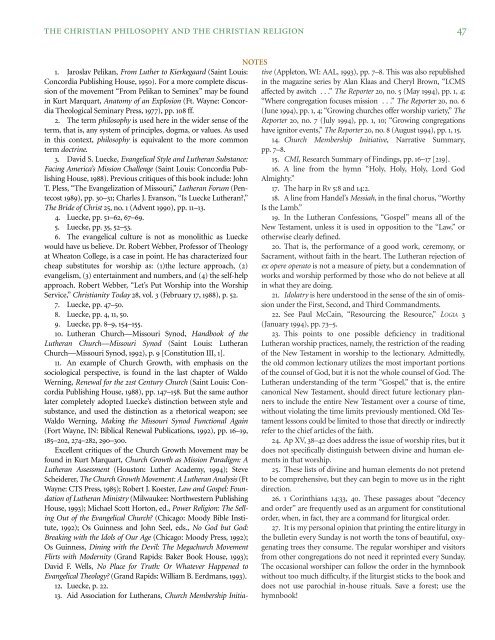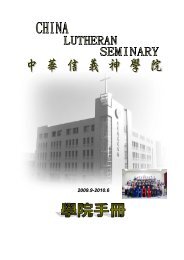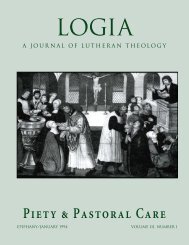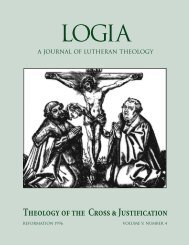04-2 Hermeneutics.pdf
04-2 Hermeneutics.pdf
04-2 Hermeneutics.pdf
- No tags were found...
Create successful ePaper yourself
Turn your PDF publications into a flip-book with our unique Google optimized e-Paper software.
THE CHRISTIAN PHILOSOPHY AND THE CHRISTIAN RELIGION 471. Jaroslav Pelikan, From Luther to Kierkegaard (Saint Louis:Concordia Publishing House, 1950). For a more complete discussionof the movement “From Pelikan to Seminex” may be foundin Kurt Marquart, Anatomy of an Explosion (Ft. Wayne: ConcordiaTheological Seminary Press, 1977), pp. 108 ff.2. The term philosophy is used here in the wider sense of theterm, that is, any system of principles, dogma, or values. As usedin this context, philosophy is equivalent to the more commonterm doctrine.3. David S. Luecke, Evangelical Style and Lutheran Substance:Facing America’s Mission Challenge (Saint Louis: Concordia PublishingHouse, 1988). Previous critiques of this book include: JohnT. Pless, “The Evangelization of Missouri,” Lutheran Forum (Pentecost1989), pp. 30–31; Charles J. Evanson, “Is Luecke Lutheran?,”The Bride of Christ 25, no. 1 (Advent 1990), pp. 11–13.4. Luecke, pp. 51–62, 67–69.5. Luecke, pp. 35, 52–53.6. The evangelical culture is not as monolithic as Lueckewould have us believe. Dr. Robert Webber, Professor of Theologyat Wheaton College, is a case in point. He has characterized fourcheap substitutes for worship as: (1)the lecture approach, (2)evangelism, (3) entertainment and numbers, and (4) the self-helpapproach. Robert Webber, “Let’s Put Worship into the WorshipService,” Christianity Today 28, vol. 3 (February 17, 1988), p. 52.7. Luecke, pp. 47–50.8. Luecke, pp. 4, 11, 50.9. Luecke, pp. 8–9, 154–155.10. Lutheran Church—Missouri Synod, Handbook of theLutheran Church—Missouri Synod (Saint Louis: LutheranChurch—Missouri Synod, 1992), p. 9 [Constitution III, 1].11. An example of Church Growth, with emphasis on thesociological perspective, is found in the last chapter of WaldoWerning, Renewal for the 21st Century Church (Saint Louis: ConcordiaPublishing House, 1988), pp. 147–158. But the same authorlater completely adopted Luecke’s distinction between style andsubstance, and used the distinction as a rhetorical weapon; seeWaldo Werning, Making the Missouri Synod Functional Again(Fort Wayne, IN: Biblical Renewal Publications, 1992), pp. 16–19,185–202, 274–282, 290–300.Excellent critiques of the Church Growth Movement may befound in Kurt Marquart, Church Growth as Mission Paradigm: ALutheran Assessment (Houston: Luther Academy, 1994); SteveScheiderer, The Church Growth Movement: A Lutheran Analysis (FtWayne: CTS Press, 1985); Robert J. Koester, Law and Gospel: Foundationof Lutheran Ministry (Milwaukee: Northwestern PublishingHouse, 1993); Michael Scott Horton, ed., Power Religion: The SellingOut of the Evangelical Church? (Chicago: Moody Bible Institute,1992); Os Guinness and John Seel, eds., No God but God:Breaking with the Idols of Our Age (Chicago: Moody Press, 1992);Os Guinness, Dining with the Devil: The Megachurch MovementFlirts with Modernity (Grand Rapids: Baker Book House, 1993);David F. Wells, No Place for Truth: Or Whatever Happened toEvangelical Theology? (Grand Rapids: William B. Eerdmans, 1993).12. Luecke, p. 22.13. Aid Association for Lutherans, Church Membership Initia-NOTEStive (Appleton, WI: AAL, 1993), pp. 7–8. This was also republishedin the magazine series by Alan Klaas and Cheryl Brown, “LCMSaffected by awitch . . .” The Reporter 20, no. 5 (May 1994), pp. 1, 4;“Where congregation focuses mission . . .” The Reporter 20, no. 6(June 1994), pp. 1, 4; “Growing churches offer worship variety,” TheReporter 20, no. 7 (July 1994), pp. 1, 10; “Growing congregationshave ignitor events,” The Reporter 20, no. 8 (August 1994), pp. 1, 15.14. Church Membership Initiative, Narrative Summary,pp. 7–8.15. CMI, Research Summary of Findings, pp. 16–17 [219].16. A line from the hymn “Holy, Holy, Holy, Lord GodAlmighty.”17. The harp in Rv 5:8 and 14:2.18. A line from Handel’s Messiah, in the final chorus, “WorthyIs the Lamb.”19. In the Lutheran Confessions, “Gospel” means all of theNew Testament, unless it is used in opposition to the “Law,” orotherwise clearly defined.20. That is, the performance of a good work, ceremony, orSacrament, without faith in the heart. The Lutheran rejection ofex opere operato is not a measure of piety, but a condemnation ofworks and worship performed by those who do not believe at allin what they are doing.21. Idolatry is here understood in the sense of the sin of omissionunder the First, Second, and Third Commandments.22. See Paul McCain, “Resourcing the Resource,” LOGIA 3(January 1994), pp. 73–5.23. This points to one possible deficiency in traditionalLutheran worship practices, namely, the restriction of the readingof the New Testament in worship to the lectionary. Admittedly,the old common lectionary utilizes the most important portionsof the counsel of God, but it is not the whole counsel of God. TheLutheran understanding of the term “Gospel,” that is, the entirecanonical New Testament, should direct future lectionary plannersto include the entire New Testament over a course of time,without violating the time limits previously mentioned. Old Testamentlessons could be limited to those that directly or indirectlyrefer to the chief articles of the faith.24. Ap XV, 38–42 does address the issue of worship rites, but itdoes not specifically distinguish between divine and human elementsin that worship.25. These lists of divine and human elements do not pretendto be comprehensive, but they can begin to move us in the rightdirection.26. 1 Corinthians 14:33, 40. These passages about “decencyand order” are frequently used as an argument for constitutionalorder, when, in fact, they are a command for liturgical order.27. It is my personal opinion that printing the entire liturgy inthe bulletin every Sunday is not worth the tons of beautiful, oxygenatingtrees they consume. The regular worshiper and visitorsfrom other congregations do not need it reprinted every Sunday.The occasional worshiper can follow the order in the hymnbookwithout too much difficulty, if the liturgist sticks to the book anddoes not use parochial in-house rituals. Save a forest; use thehymnbook!
















